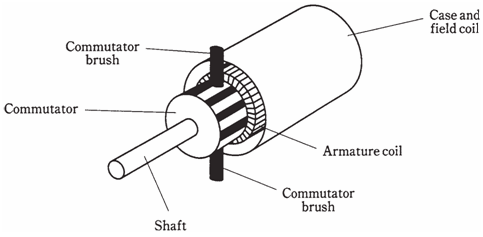Magnetic tape
Recording tape is stuff you find in the cassette players. It is sometimes seen on reel to reel devices. Now days, magnetic tape is used for home entertainment, especially hi fi music and home video.

Figure-- Cutaway view of a dc motor.
The tape itself has of millions of particles of iron oxide, attached to the plastic or mylar strip. A fluctuating magnetic field, obtained by recording head, polarizes the particles. As the field changes in the strength next to the recording head, the tape passes by at the constant, controlled speed. This produces regions in which the iron oxide particles are polarized in either direction.
When the tape is run at same speed through the recorder in the playback mode, the magnetic fields around individual particles creates a fluctuating field which is detected by the pickup head. This field has same pattern of variations as the original field from recording head.
The magnetic tape is available in various widths and thicknesses, for various applications. The thicker tapes result in cassettes which don not play as long, but the tape is resistant to stretching more. The speed of the tape determines fidelity of the recording. Higher speeds are preferred for the music and video, and lower speeds are preferred for voice.
The data on the magnetic tape can be distorted or erased by the external magnetic fields. Thus, tapes should be protected from such fields. Keep magnetic tape away from the magnets. Extreme heat can result in the loss of data, and even physical damage to the tape.